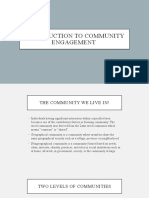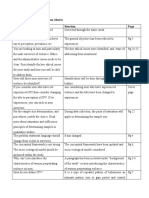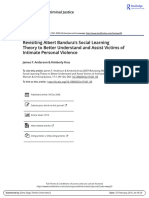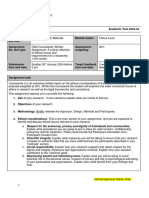0 ratings0% found this document useful (0 votes)
10 viewsNSTP Mod2
NSTP Mod2
Uploaded by
Mary Joy Pangan BarcelonaCommunity refers to a social group that shares common values and helps each other. There are different types of communities defined by location, culture, or organizations. The essential elements of community include a group of people in a definite locality who share sentiments, customs, and interests. Community work involves mobilizing communities to address their own problems through participation and empowerment. Characteristics of effective community work include working towards common goals, allowing freedom of expression, promoting fairness, and celebrating community heritage. There are four main types of community engagement focused on development, participation, helping organizations, and social change.
Copyright:
© All Rights Reserved
Available Formats
Download as DOCX, PDF, TXT or read online from Scribd
NSTP Mod2
NSTP Mod2
Uploaded by
Mary Joy Pangan Barcelona0 ratings0% found this document useful (0 votes)
10 views2 pagesCommunity refers to a social group that shares common values and helps each other. There are different types of communities defined by location, culture, or organizations. The essential elements of community include a group of people in a definite locality who share sentiments, customs, and interests. Community work involves mobilizing communities to address their own problems through participation and empowerment. Characteristics of effective community work include working towards common goals, allowing freedom of expression, promoting fairness, and celebrating community heritage. There are four main types of community engagement focused on development, participation, helping organizations, and social change.
Original Title
nstp-mod2
Copyright
© © All Rights Reserved
Available Formats
DOCX, PDF, TXT or read online from Scribd
Share this document
Did you find this document useful?
Is this content inappropriate?
Community refers to a social group that shares common values and helps each other. There are different types of communities defined by location, culture, or organizations. The essential elements of community include a group of people in a definite locality who share sentiments, customs, and interests. Community work involves mobilizing communities to address their own problems through participation and empowerment. Characteristics of effective community work include working towards common goals, allowing freedom of expression, promoting fairness, and celebrating community heritage. There are four main types of community engagement focused on development, participation, helping organizations, and social change.
Copyright:
© All Rights Reserved
Available Formats
Download as DOCX, PDF, TXT or read online from Scribd
Download as docx, pdf, or txt
0 ratings0% found this document useful (0 votes)
10 views2 pagesNSTP Mod2
NSTP Mod2
Uploaded by
Mary Joy Pangan BarcelonaCommunity refers to a social group that shares common values and helps each other. There are different types of communities defined by location, culture, or organizations. The essential elements of community include a group of people in a definite locality who share sentiments, customs, and interests. Community work involves mobilizing communities to address their own problems through participation and empowerment. Characteristics of effective community work include working towards common goals, allowing freedom of expression, promoting fairness, and celebrating community heritage. There are four main types of community engagement focused on development, participation, helping organizations, and social change.
Copyright:
© All Rights Reserved
Available Formats
Download as DOCX, PDF, TXT or read online from Scribd
Download as docx, pdf, or txt
You are on page 1of 2
COMMUNITY TYPES OF COMMUNITY
Geographical communities: Refers to communities of location.
Range from the local neighborhood, village, town or city, region,
COMMUNITY nation or even the planet as a whole.
- Refers to a social unit larger than a small village that shares Communities of culture: They may be included as communities
common values. It is a group or society helping each other. of need or identity. Range from the subculture, ethnic group,
- A place where people care for each other and support the religious, or the global community of cultures today.
growth of families and children.
Community organizations: range from informal family or kinship
ESSENTIAL ELEMENTS OF COMMUNITY networks, to more formal incorporated associations, political
Group of People: community is a group of human beings. It is not decision making structures, economic enterprises, or professional
possible to form a community. associations at a small, national or international scale.
Definite locality: The physical basis of community. A community COMMUNITY WORK
always
occupies geographical area. - Concerned with the development and empowerment of
communities through facilitating the active participation of people in
Community sentiment: Means a feeling of belonging together. The addressing issues that affect them collectively.
members of a community speak the same language, conform to the
same - It is a planned process to mobilize communities to use their own
mores, possess the same sentiment, and have the same attitudes. social structures and resources to address their own problems and
Likeness: The people in a community share a common way of life. achieve their own objectives.
Their customs, transitions, language, etc., are similar.
- Focuses on participation and fosters empowerment, and change
Permanency: A community is not temporary like a crowd or a mob. through collective action.
It is relatively stable. It includes a permanent life in a definite place.
CHARACTERISTICS OF COMMUNITY WORK
Particular name: It points identity, it indicates reality, it points out
individuality, and it often describes personality. Work together toward a common goal.
The most effective communities share similar values and belief
Size: A common community may be big or small.
systems that cooperate to help accomplish one or several goals.
Wider ends: People in the community share several common
interests. People work together to fulfill some common interest. Allow freedom of expression.
Regulation of Relations: Every community in course of time Individuals who feel encourage to give their input about an issue,
develops a system of traditions, customs, and morals. who feel heard when they do speak their minds are more likely to
feel connected to their community.
Promote fairness COMMUNITY DEVELOPMENT
Positive communities work to ensure that those who fall in
In practice, community development:
minority populations are not treated differently.
1. Support communities, of place and identity, to use their own
Set clear policies and obligations. assets to improve the quality of community life.
Communities work to encourage community members to fulfill
their obligations. This may include things as attending community 2. Helps communities in public agencies to work together to
meetings or paying taxes. improve services and the way in which decisions are made.
Celebrate community heritage 3. Community development is fundamentally based on the values
Efficient communities embrace their culture by reminding of human rights, social justice, equality and respect for
members of the long way the community has come. diversity.
Promote interaction among members
FOUR TYPES OF COMMUNITY ENGAGEMENT
Creating a feeling of connection works to make members more
motivated to meet their obligations and work towards the 1. Community engagement with a focus on community
established goals of the community. development
Elect leaders that stand by community values 2. Community participation
Individuals elected to leadership positions within positive
communities should be fair and just in their political focus. 3. Community engagement that helps organizations,
businesses, etc.
Prioritize effective communication
Leaders ensure that all members are aware of the projects currently 4. Community engagement as part of social change
in process, as well as what they can do to help those projects run movement.
smoothly.
COMMUNITY DEVELOPMENT
- A process whereby those who are marginalized and excluded from
society are enabled to gain self-confidence and to join with others.
- It provides the foundation a city needs to improve the lives of its
citizens. It creates strong and diverse communities.
You might also like
- Community OrganizingDocument145 pagesCommunity OrganizingShaira Bagayas Tanguis100% (1)
- Sinclair, Dale (2019) Lead Designers Handbook The Lead Designer and Design ManagementDocument270 pagesSinclair, Dale (2019) Lead Designers Handbook The Lead Designer and Design Managementalexandra SBNo ratings yet
- Pre Test Eapp 2022 23Document3 pagesPre Test Eapp 2022 23Kianna Marie Vitug100% (2)
- Facilitating Learning Prof Ed LET Reviewer-1Document8 pagesFacilitating Learning Prof Ed LET Reviewer-1KIMBERLY TA�AMOR PORTUGAL100% (4)
- Mind Wandering During Lectures I: Changes in Rates Across An Entire Semester Wammes Et Al., STLP1Document20 pagesMind Wandering During Lectures I: Changes in Rates Across An Entire Semester Wammes Et Al., STLP1Elena SinelNo ratings yet
- Eapp, TASKDocument3 pagesEapp, TASKMary Jane PobleteNo ratings yet
- Introduction To Community EngagementDocument6 pagesIntroduction To Community EngagementJohnrommel ErcillaNo ratings yet
- Cesc 3RD Q ReviewerDocument8 pagesCesc 3RD Q ReviewerJohn CatakotanNo ratings yet
- Module 1. Definition of CommunityDocument35 pagesModule 1. Definition of Communityjasmin.villanueva0202No ratings yet
- Cesc L1Document8 pagesCesc L1alexisprescillas24No ratings yet
- REPORTDocument16 pagesREPORTNeha MaddheshiyaNo ratings yet
- NSTP2 Unit10 Module 2ND Sem 2022 2023Document9 pagesNSTP2 Unit10 Module 2ND Sem 2022 2023Aliah RiveraNo ratings yet
- 1st Periodical Test - Community EngagementDocument4 pages1st Periodical Test - Community EngagementCherie AnnNo ratings yet
- Mid CescDocument3 pagesMid Cesc12 EPHRAIM PRINCESS FAITH E. FRONTADANo ratings yet
- Unit Vii. Community Service/ImmersionDocument7 pagesUnit Vii. Community Service/ImmersionKen KanekiNo ratings yet
- Cesc M1Document24 pagesCesc M1Marc Byron Manguba100% (1)
- Reviewer in Community EngagementDocument25 pagesReviewer in Community EngagementJanel Allison OligarioNo ratings yet
- Lesson 1 CESCDocument3 pagesLesson 1 CESCMarianne Jewel Monte ServillaNo ratings yet
- Lesson 1: The Importance of Understanding Community & Community ActionDocument2 pagesLesson 1: The Importance of Understanding Community & Community ActionCaselyn Magat BuzonNo ratings yet
- Community, Engagement, Solidarity, and CitizenshipDocument2 pagesCommunity, Engagement, Solidarity, and CitizenshipCasimiro JustineNo ratings yet
- COSADocument6 pagesCOSAnjsince1998No ratings yet
- Cesc Lesson 1 Quarter 1Document3 pagesCesc Lesson 1 Quarter 1jeraldin julatonNo ratings yet
- Nature of Community Work: Cwts - 2 SemesterDocument7 pagesNature of Community Work: Cwts - 2 SemesterDA SulitNo ratings yet
- CESC 1aDocument32 pagesCESC 1aJoana MarieNo ratings yet
- Chapter One Introduction To Community Development For Social Change Defining CommunityDocument35 pagesChapter One Introduction To Community Development For Social Change Defining CommunityJala CabañerosNo ratings yet
- The Concept of Community in Social Work Practice: Reported By: Patricia L. DelosreyesDocument17 pagesThe Concept of Community in Social Work Practice: Reported By: Patricia L. DelosreyesJeremiah MagcalasNo ratings yet
- Concept of CommunityDocument31 pagesConcept of CommunitymarkdavelabisNo ratings yet
- Practical Research LL FinalDocument6 pagesPractical Research LL FinalquirolkarlyleannNo ratings yet
- Comdev CC SF ReviewerDocument6 pagesComdev CC SF ReviewerPaul Jastine RodriguezNo ratings yet
- CD Writen ExamDocument6 pagesCD Writen Exampaalan123455No ratings yet
- MSW Semester Ii Sow 2 C 08: Community Organization and Social ActionDocument140 pagesMSW Semester Ii Sow 2 C 08: Community Organization and Social ActionAnto alappattNo ratings yet
- Advanced Community - Change - and - Development - Study - NotesDocument35 pagesAdvanced Community - Change - and - Development - Study - Notesfarai mashokoNo ratings yet
- Community Typologies: Group 2Document43 pagesCommunity Typologies: Group 2Rodine Jade De JesusNo ratings yet
- Community Engagement, Solidarity and Citizenship: First Quarter - Module 1Document19 pagesCommunity Engagement, Solidarity and Citizenship: First Quarter - Module 1Aries Jen Palaganas100% (1)
- ASPECN2 - Research 100Document13 pagesASPECN2 - Research 100Robert AlonsoNo ratings yet
- Community Engagement, Solidarity, & Citizenship: Week 1-2Document8 pagesCommunity Engagement, Solidarity, & Citizenship: Week 1-2jopals23No ratings yet
- Contextualize LAS - Week 1Document2 pagesContextualize LAS - Week 1amariahval282023No ratings yet
- Community Development PDFDocument22 pagesCommunity Development PDFKaRin Zaoldyeck100% (1)
- Community Organization: Henelyn L. Lapizar, RSW February 12, 2022Document36 pagesCommunity Organization: Henelyn L. Lapizar, RSW February 12, 2022likeylyca Cuarez100% (1)
- COMMUNITY ENGAGEMENT, Lesson 1Document12 pagesCOMMUNITY ENGAGEMENT, Lesson 1Robert BalinoNo ratings yet
- Community Engagement NOTESDocument3 pagesCommunity Engagement NOTESArchival Nejudne100% (2)
- Application of Community Psy @lubna Ishtiaq UOG@Document9 pagesApplication of Community Psy @lubna Ishtiaq UOG@Lubna Ishtiaq67% (3)
- SW117 Reviewer2.0Document5 pagesSW117 Reviewer2.0GWYENETH MAY MARGATENo ratings yet
- Community Organization 1Document172 pagesCommunity Organization 1androos achayanNo ratings yet
- NSTP2 Volunteerism 2Document17 pagesNSTP2 Volunteerism 2j.rollorata.488841No ratings yet
- CESC Module 1 Lesson 1Document73 pagesCESC Module 1 Lesson 1Angelbert SalgadoNo ratings yet
- NSTP LectureDocument37 pagesNSTP LectureLester Evangelista100% (2)
- Inbound 7477486757198347463Document24 pagesInbound 7477486757198347463karlazeillpNo ratings yet
- Cesc Handouts q1Document8 pagesCesc Handouts q1sandra mae dulay100% (1)
- NSTP 2Document6 pagesNSTP 2Hes Jhen BarrioNo ratings yet
- Block-1 Concepts of Community and Community DevelopmentDocument103 pagesBlock-1 Concepts of Community and Community DevelopmentAnanta ChaliseNo ratings yet
- Community EngagementDocument8 pagesCommunity EngagementAllanah SalaverNo ratings yet
- Community EngagementDocument21 pagesCommunity Engagementmadilag nNo ratings yet
- CESC - Lesson 1 (Community Dynamics and Community ACtion)Document44 pagesCESC - Lesson 1 (Community Dynamics and Community ACtion)Cherryl MarigocioNo ratings yet
- Reviewer For CEDocument5 pagesReviewer For CEMarcelo CruzNo ratings yet
- 1st Periodical Exam in Community Engagement Solidarity and Citizenship ReviewerDocument6 pages1st Periodical Exam in Community Engagement Solidarity and Citizenship ReviewerJohn Aries TejadaNo ratings yet
- Community Engagement, Solidarity and Citizenship: First Quarter - Module 1Document18 pagesCommunity Engagement, Solidarity and Citizenship: First Quarter - Module 1ANN LYNN RABULANNo ratings yet
- Community Development MethodDocument6 pagesCommunity Development MethodAmna ZaidNo ratings yet
- Community Engagement, Solidarity and Citizenship: First Quarter - Module 1Document19 pagesCommunity Engagement, Solidarity and Citizenship: First Quarter - Module 1Alethea Sanchez100% (1)
- Community Engagement, Solidarity and CitizenshipDocument9 pagesCommunity Engagement, Solidarity and CitizenshipJoel Briones100% (3)
- Community Engagement, Solidarity and CitizenshipDocument17 pagesCommunity Engagement, Solidarity and CitizenshipKatrin Joy Pornosdoro100% (2)
- Group 2 NSTPDocument13 pagesGroup 2 NSTPBea TorrecampoNo ratings yet
- Comparison of Algorithms in Foreign Exchange Rate PredictionDocument5 pagesComparison of Algorithms in Foreign Exchange Rate PredictionshrutiNo ratings yet
- SELAMAWIT Final EditedDocument62 pagesSELAMAWIT Final EditedAbnet BeleteNo ratings yet
- GE 4 Unit 1 Lesson 4Document31 pagesGE 4 Unit 1 Lesson 4Walwal WalwalNo ratings yet
- Unit Planner Short Story Unit 5 Grade 9, Q-1 LaurieDocument6 pagesUnit Planner Short Story Unit 5 Grade 9, Q-1 LaurieAli Al ShehabNo ratings yet
- Research Article: Application of Fuzzy Linear Programming Model in Agricultural Economic ManagementDocument13 pagesResearch Article: Application of Fuzzy Linear Programming Model in Agricultural Economic ManagementMuhammad Fauzan Zul AzmiNo ratings yet
- Aol Mid Group 3Document24 pagesAol Mid Group 3Belen Maria ChristineNo ratings yet
- Nat Reviewer 1 Oral Communication in ContextDocument6 pagesNat Reviewer 1 Oral Communication in Contextbertz sumayloNo ratings yet
- Lecture 17 Basic ElectronicsDocument43 pagesLecture 17 Basic ElectronicsRKNo ratings yet
- The Role of Strategic Internal Communication in Empowering Female Employees To Cope With Workplace Gender DiscriminationDocument22 pagesThe Role of Strategic Internal Communication in Empowering Female Employees To Cope With Workplace Gender Discriminationofelia acostaNo ratings yet
- Managing and Caring For The SelfDocument24 pagesManaging and Caring For The SelfEunice Anne WaganNo ratings yet
- ps2 Summative ReportDocument6 pagesps2 Summative Reportapi-643858084No ratings yet
- EOI Cote Dor Data Technology Park Park 25 June 20 FinalDocument13 pagesEOI Cote Dor Data Technology Park Park 25 June 20 FinalClaire AlbaretNo ratings yet
- Visual Analytics For Maritime Anomaly Detection (PDFDrive)Document252 pagesVisual Analytics For Maritime Anomaly Detection (PDFDrive)Ali AyubNo ratings yet
- Introduction To LinguisticsDocument13 pagesIntroduction To Linguisticsnava anggri100% (4)
- How To Write Scope and Limitations of ThesisDocument6 pagesHow To Write Scope and Limitations of ThesisChristine Maffla100% (2)
- Promotionand Preservationof CulturalDocument14 pagesPromotionand Preservationof CulturalK61 NGUYỄN HẢI ANHNo ratings yet
- Embedding Action Research For Reflective Teaching: Learning Episode 2Document38 pagesEmbedding Action Research For Reflective Teaching: Learning Episode 2RUSTOM GATONNo ratings yet
- Proposal Defense Correction Matrix Comment ReactionDocument2 pagesProposal Defense Correction Matrix Comment ReactionIZIMBA63% (8)
- Bedside Clinic: Presented byDocument21 pagesBedside Clinic: Presented bysahil muhammed0% (1)
- Bandura's TheoryDocument27 pagesBandura's TheorycarsiwanNo ratings yet
- A Study On Employee Retention With Special Reference Chettinad Cement AriyalurDocument6 pagesA Study On Employee Retention With Special Reference Chettinad Cement Ariyalurप्रेम हेNo ratings yet
- Fpsyg 08 01153Document11 pagesFpsyg 08 01153ummumasrurohNo ratings yet
- BM631 CW2 Assignment Brief 2023-24Document9 pagesBM631 CW2 Assignment Brief 2023-24Tanasa Stefan IonutNo ratings yet
- GRADES 1 To 12 Daily Lesson Log Monday Tuesday Wednesday Thursday FridayDocument4 pagesGRADES 1 To 12 Daily Lesson Log Monday Tuesday Wednesday Thursday FridayAlma SabellanoNo ratings yet
- CS490D: Introduction To Data Mining: Chris CliftonDocument28 pagesCS490D: Introduction To Data Mining: Chris CliftonNaziaNo ratings yet
- Predictive Analysis of Diabetes Without Data Pre-Processing Via The Evaluation of Tree AlgorithmsDocument11 pagesPredictive Analysis of Diabetes Without Data Pre-Processing Via The Evaluation of Tree AlgorithmsIJAR JOURNALNo ratings yet

























































































